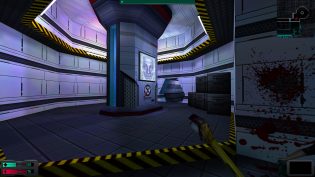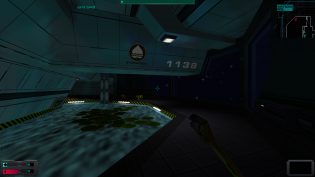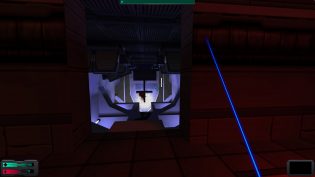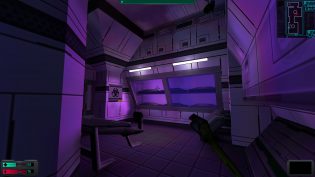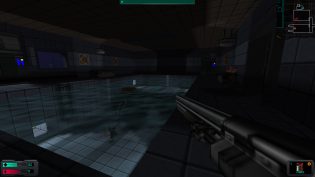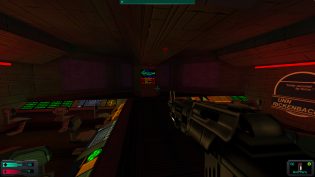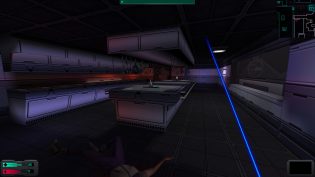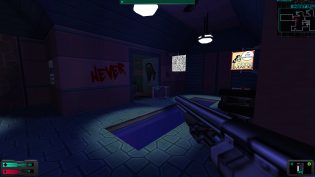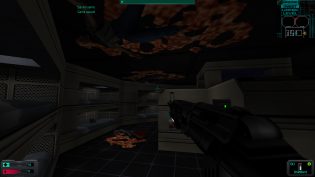O tempora is a series of retrospective posts where I play games from ages before to see if they stood the test of time.
This has been a long time coming. I’ve attempted to play System Shock 2 ever since 2001, when I first got my own modern (for the time) PC. And even back then, just few years after the game release, it already worked with issues. After that for the longest all games on this in-house game engine made by Looking Glass Studios, along with the Thief 1 and 2, were borderline unplayable on most PCs. Until one day a mysterious person (often believed to be one of the ex-Looking Glass employees), released an updated version of the source code of the engine, which made things work again. Ever since then, all 3 games on the Dark Engine have been receiving updates and fixes making games not just playable again, but often better than they were originally. And several years since I had a chance to replay all the Thief titles and a year and a half since I’ve first experienced the innovative undying beauty of the original System Shock, I finally had the chance to finish System Shock 2. And I can sum up my experience in a very short review: Wow…
For more in-depth analysis, read on. :)
System Shock 2, for all intents and purposes, feels like a remake of the original game. Even reading through the original game pitch document for “Junction Point” (working title of the game) it becomes clear that Irrational Games and Looking Glass Studios were effectively looking at the first game and thinking – okay, but what if we made it more like Ultima Underworld, like we originally planned to do, and what if we upped the quality of visuals and audio and make the innovative interface work in the modern era of 1999? The setup is similar – you wake up on a gigantic space vessel (ship instead of a station this time) after several months of restoration after a cybernetic chip being installed in your head and find the place you’re in to be completely trashed and in chaos. There’s a crazed ship AI, except this time it seems to be controlled by some mutant creatures, instead of the other way around. Most people are dead or dying, being hunted by these hybrids, who serve the “Many”, being implanted with parasites, not unlike what SHODAN was doing with turning people into cyborgs on Citadel station. And even most of the game mechanics, locations, puzzles and situations feel either directly inspired by the original game, or sometimes almost copying it.
But before we get to the space vessel, there is an introductory part that features one major change, that makes this game closer to Ultima Underworld – there’re RPG mechanics now. During the intro you “create a character”, essentially, by selecting one of the 3 preset classes and learn about spending the skill points and stats, which will differ as you start the game depending on your choices. Although, later down the line, no one is forbidding you to learn other skills and develop into a different character using the “cyber modules”, which work like skill points here. And I’ll probably be in the minority here, but I think this system makes System Shock 2 worse than it could’ve been otherwise.
Let me explain what I mean. You see, unlike the later titles that got inspired by the RPG concepts in this game, like Deus Ex or BioShock, and unlike the predecessor, which was actually closer the BioShock in the concept of upgrades, the RPG mechanics in System Shock 2 feel half-baked and badly implemented. There are skills and stats that you absolutely must have, on any difficulty and there are skills and stats that are close to useless and the only really major choice you might have is – focusing on being the Psi-driven character, focusing on having some Psi-abilities, or just completely ditching the Psi. These ideas would work fantastically well with the more upgrade-based system, like the chips you can find in this game and the predecessor and what “plasmids” did in Bioshock, but doesn’t really work with the more traditional RPG-like upgrade stats/skills system.
The weapons and enemies are still as specialized as in the original game, with some exploding on contact or after death, thus being a bad choice for melee, some being more susceptible for energy damage, and some to standard damage. But now you have to dedicate skill points to trees, to specialize in specific weapons, which might turn out to be mostly useless either in general, or for the specific build that you eventually become. No respecs, by the way, so if you decided to dump all your skill points into Modification, don’t feel bad later.
The choice of weapons and the fact that they now degrade from use can become especially annoying due to the fact that enemies respawn constantly and way too often, which on your first playthrough of the game, can become hell. As you will be running back and forth between few rooms at times seeing new enemies spawn out of thin air (they teleport in), while having no clue where to go next. It clearly wants to up the tension, and works like that when you learn the layout and where to go, but until you do, no minimap can help. It’s infuriating when you’re low on items, don’t use psionics, kill the self-destructing bot then have to backtrack less than a minute later to see that the bot has already respawned and is extremely happy to explode in your face. No healing and little ammo these enemies provide can fix this high respawn rate.
To finish on the frustrating bits, some of the maps, especially close to the end of the game, are very hard to navigate and make sense of. And sometimes to traverse as well, since the game uses the same main character full body awareness physics as the first two Thief games, which is both a blessing and a curse. On one hand, you have a situation where you character can lean in different directions (including forward!), can react to all the different debris and changes in terrain in a way that pretty much no games since then have done. It’s a simulation on an incredible level. But it also means that you can get stuck in some places, character not willing to jump, because it expects to climb, but climbing not working because the obstacle is too low or irregular in shape. And hitting enemies in melee is frustrating at times, because of these differences in sizes and positions actually being taken into account, so you need to duck or lean forward and down to hit a short enemy, otherwise you’re just swinging at the air.
But I’ve ran out of bad things to say, so let me tell you how absolutely amazing this game is. Yes, the above issues are big and smaller frustrations that can make getting into the game harder, especially since there is no amazing modular approach to “difficulty” like what the original game had (where you could turn it into story-exploration games with no combat and puzzles, or into a story-void difficult first person horror action). But overcoming those frustration pays off so much. In fact, for the first 60% of the game I didn’t even think much about the things described above. And only during very late locations all the issues started to become notable. Still, from start to finish, the game just oozes charm and charisma. It looks outdated, sure, but the visual direction of the game makes up for the blockiness of things. It’s easy to just suspend the disbelief and imagine yourself on the incredibly creepy Von Braun spaceship, as you carefully explore it, unlocking new areas, each completely different from the last, music changing from atmospheric ambiance to sudden electronic action bits that drive you on. And the voice acting…
Voice acting and script in this game don’t just hold up to this day, together with the atmosphere the game builds up in general, they outdo so many modern projects, including the popular BioShock. The voicelogs range from “just here to help, but still feel like natural part of world building”, to “oh gods, that was horrifying to listen to”. While the first game had only SHODAN as a truly remarkable voice, with lots of memorable lines, and few exceptions in other characters, in System Shock 2 you will be hard pressed to find a voice log that you can genuinely call “boring” or “not interesting in the slightest”. And the good, memorable ones? Oh, they are aplenty.
Every room you walk into, almost every NPC noise and “voice bark” you hear, still feels like a true benchmark in world building. In the original game, the music was smartly used to hint you at the presence of enemies, but in this one, you hear the enemies themselves. And even the most “disposable”, most common “zombies” (the Hybrids) will haunt your dreams with their “we are, we are” and “your flesh betrays you”. System Shock 2, like Thief games, feels like such a high quality level of mood building via the visual and sound design that few games were able to reach ever since.
And that’s what System Shock 2 is – a game that has some definite flaws (and I still would argue that System Shock 1 and it’s lack of clear RPG mechanics had a better idea) remains something games try to use as a benchmark, as a level to reach and, hopefully, surpass. But none do. There’s something amazingly balanced in how the world, the gameplay, the story, the visual and sound design work together, almost never overstepping each other. Something, that pretty much no game has been able to at least recreate for almost 19 years now. I would highly recommend playing System Shock 2 if you haven’t already. And if you did, but a long time ago, the current updated version available on GOG and Steam works amazingly well on modern systems and modern resolutions, so you might have an even better time with the game now out of the box than you had the first time around.




